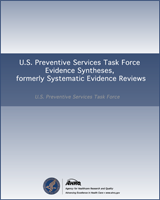From: 3, Methods

Lung Cancer Screening: An Update for the U.S. Preventive Services Task Force [Internet].
Systematic Evidence Reviews, No. 31.
Humphrey LL, Johnson M, Teutsch S.
Rockville (MD): Agency for Healthcare Research and Quality (US); 2004 May.
NCBI Bookshelf. A service of the National Library of Medicine, National Institutes of Health.